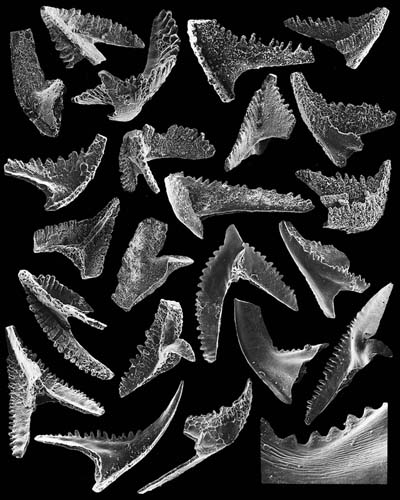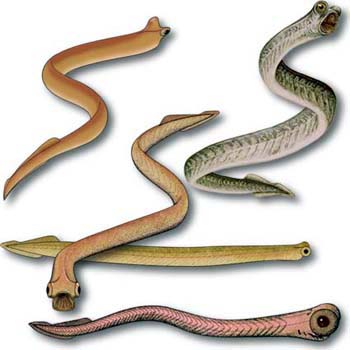The conodonts, these strangers
The conodonts (Conodonta) are a mysterious group of animals lived in the Paleozoic and early Mesozoic (from the upper Cambrian to Upper Triassic). For more than a century, these beings were known only by their fossil strange mouthparts, only in 1983 was discovered the first fossil of the animal complete rest, followed by others in the early 90s.
It is believed that the entire class of conodonts has disappeared after the great mass extinction event occurred between the Triassic and Jurassic, ie approximately 200 million years ago.
These animals were considered one of the great mysteries of paleontology: until the end of the 80s the taxonomic relationships of the conodonts were virtually unknown. All that came to light were tens of thousands of small toothed elements, incredibly numerous in many Paleozoic and Triassic deposits in the world.
paleontology: until the end of the 80s the taxonomic relationships of the conodonts were virtually unknown. All that came to light were tens of thousands of small toothed elements, incredibly numerous in many Paleozoic and Triassic deposits in the world.
Throughout the 800 and much of the '900 these microfossils were found isolated from each other; 60s few remains found close together, in the possible relationship between the different anatomical remains, were recognized as part of a complex structure belonging to a single body with the body made solely from soft tissues, was buried in the place where he had died, with no post-mortem transport that would destroy the anatomical structure. The apparatus conodonte, as it was called, was composed of many elements conodonts, in relation to each other and of different shape. The function of this apparatus remained uncertain, even if it was hypothesized that was used by the animal to eat. The animal owner of this apparatus there was no trace.
In 1983 he was discovered in a field of type Konservat-Lagerstätten, in the lower layers of the Carboniferous of Scotland, a complete specimen, with lots of equipment conodonta. Clydagnathus windsorensis, the scientific name, allowed him to elucidate many obscure points connected with these animals: the animal conodonte was about four centimeters long, provided with an elongated worm-like body and a bulbous head .
The body resembles that of the current amphioxus, with lots of notochord and segmented musculature. A few years later, in Ordovician strata of South Africa came into existence a second specimen of the larger named Promissum pulchrum, it was up to 40 cm in length.
 For more than a century, these bizarre animals have led to a crisis of paleontologists classifications: certainly , however, were very few scholars who had an affinity with suspected vertebrates. It is curious to note how, in the first study of these animals (1856), Pander hypothesized that the elements conodonts belonged to some kind of extinct fish. The theory, however, was not followed, and in the following decades the hypothesis multiplied. Many paleontologists believed that these elements did not even part of mouthparts.
For more than a century, these bizarre animals have led to a crisis of paleontologists classifications: certainly , however, were very few scholars who had an affinity with suspected vertebrates. It is curious to note how, in the first study of these animals (1856), Pander hypothesized that the elements conodonts belonged to some kind of extinct fish. The theory, however, was not followed, and in the following decades the hypothesis multiplied. Many paleontologists believed that these elements did not even part of mouthparts.
Only the findings of the 80s and 90s made it possible to say that the intuition of Pander was correct. Currently the conodonts are considered the most primitive vertebrates, perhaps the most advanced of lampreys, with a single type of mouthparts. The puzzles however, are not finished: there are those who think that the strange bulbous structures placed on top of the "skull" are big eyes, those who believed that they could be part of the mechanism mug. Even the paleobiology of these animals is entirely unknown.


 paleontology: until the end of the 80s the taxonomic relationships of the conodonts were virtually unknown. All that came to light were tens of thousands of small toothed elements, incredibly numerous in many Paleozoic and Triassic deposits in the world.
paleontology: until the end of the 80s the taxonomic relationships of the conodonts were virtually unknown. All that came to light were tens of thousands of small toothed elements, incredibly numerous in many Paleozoic and Triassic deposits in the world.

